It better be worth it
By JC | October 4, 2011
Lately I’ve been enthralled by Estonian lace. I’m not sure what got me off on this kick, but I do know what’s fueled it along:
- Taking in the Knitted Lace of Estonia exhibit at Lacis – not in person, unfortunately, but virtually through its stunning slideshow. Don’t you just love how the photos show a clear contrast in tone between the plain knit sections, the sections with yarn overs, and the sections with nupps?
- Reading Knitted Lace of Estonia by Nancy Bush and The Haapsalu Shawl by Siiri Reimann and Aime Edasi. Fabulous books, the both of ’em.
- Placing the winning Silent Auction bid on a skein of laceweight Grignasco Prezioso at a local retreat.
Winning that skein of laceweight sealed my fate: since then, I’ve been swatching Estonian patterns, bound and determined to find a main stitch pattern and an edging that, together, will be worthy of the yarn.
You see, it’s not just that the yarn is scrumptious. (And at 85% extrafine merino and 15% cashmere, it is scrumptious. “Buttery” and “ethereal” also come to mind.) It’s not just that the yarn is discontinued. It’s not just that I got it for a steal – only $12.50 for 1500+ yards! No, I need to knit something spectacular out of the yarn for a very simple reason: I owe it to some special friends.
Picture this: You’re at a Silent Auction, scoping out the yarn and books and whatnot that other retreat members are destashing. You spy three skeins of laceweight. You’re smart enough to read the fine print on one that says “15% cashmere,” and lucky enough to place the winning bid. Thrilled beyond compare, you borrow a swift and ball winder… and discover the skein is tangled. Not horribly; not so you’d notice at first glance. But bad enough that you can’t just crank away at the ball winder. Instead, you have to HAND WIND, passing the nascent ball under a strand or two of yarn with each revolution of the swift.
Yesiree, I spent hours hand winding those 1500+ yards, with the help of friends that took pity on me. They gave up their own valuable knitting time to spin the swift so I could wind more freely. And when the yarn became even more discombobulated and the swift had to remain stationary, they stood on chairs and pulled the yarn off the top of the swift for me. Their help made the hand-winding possible; their support kept me sane. So it’s with a great debt of gratitude to Penny, Evelyn, Grace, Jeannette, and Marvina that something awesome has to come of that blasted skein of yarn.
But enough of the yarn’s story. Let’s get to the swatch photos!
I started out by knitting three nearly identical swatches, each with sections of garter, stockinette, and an Estonian pattern called Half Leaf. The first swatch was on 3.5 mm needles, and was a bit too loose. The second was on 3 mm needles, and was a bit too firm. The third, knit on size 3.25 mm needles, hit the Goldilocks sweet spot:
Isn’t Half Leaf pattern lovely? I need to design a scarf or something out of that someday.
For the shawl at hand, though, my current obsession with Estonian lace demands a main pattern with nupps, the quintessential hallmark of Estonian lace: spots where you work 5, 7, or 9 stitches into a single stitch, then knit all of ’em together on the next row. Some knitters can’t stand working nupps, finding the “knit 5 (or more) stitches together” business too fiddly for words. Me, I was pleasantly surprised when I swatched the Silvia pattern:
I liked working the nupps, no doubt thanks to needles with long tapers, yarn with a good deal of “sproing,” and a seriously loose tension on each group of nupp stitches. In contrast, I did not like working Silvia’s gathers. You’re supposed to form them by working [k5tog, yo, k5tog, yo, k5tog] into the same 5 stitches. Blech! Not fun, even with needles and yarn that permitted fairly easy nupps. Look closely at the swatch: you’ll see I omitted the gathers in its top half.
I made other small tweaks from one repeat to the next too: more or fewer plain rows between repeats, direction of decreases, that sort of thing. What can I say? I like tweaking stitch patterns.
Next up: a couple edging patterns – again, slight variations on traditional Estonian patterns. Here’s the first:
I thought maybe I could start a shawl with this edging, continue with a Silvia variation, put those stitches on hold while knitting a matching edging for the other end of the shawl, then graft the second edging to the held stitches. This would be an end-run around the traditional Estonian technique of knitting the body of a shawl first, then knitting its edging separately, and sewing it all together. Who wants seams in their shawl, right?
But, holding the edging swatch up to the Silvia swatch, I could see they didn’t seem to “go together.”
On to edging swatch #2:
This one has nupps, and in character I think it matches the Silvia-inspired pattern better:
Even better: a little Photoshop trickery places my favorite Silvia variation (which The Haapsalu Shawl book would probably refer to as a “Lily of the Valley and Flower” pattern) next to a reduced version of the edging:
Bingo! I like this combo.
Now I just have to decide whether I’m going to go with the no-sew approach – which would put edging at the top and bottom ends of the shawl only – or with the traditional approach – which would put edging on all four sides of the shawl. Normally, I’m not a slave to tradition… but both books I’ve read describe clearly what to do. And they show fab results.
What would you do?



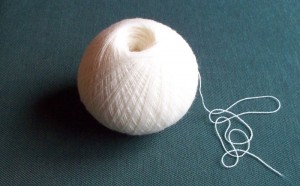
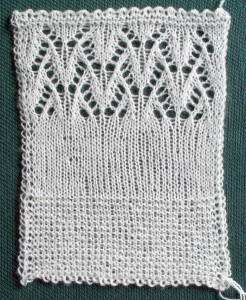

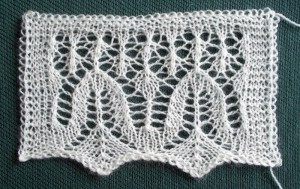
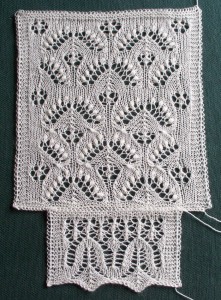

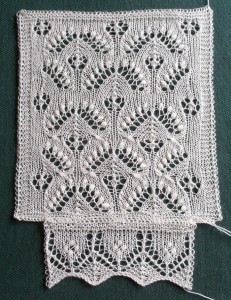

9 Comments